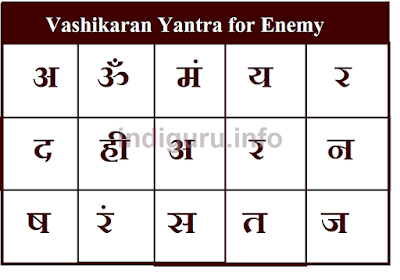This article describes a very useful Vashikaran Yantra Upay to end fights, arguments, and enmity with any person, including adversaries and enemies. This Shatru Mohini-Vashikaran Yantra acts rapidly in putting the enemy under a hypnotic spell by captivating his mind, removing the hostility and aggressiveness from his mind, and making him social and friendly.
The Vashikaran Yantra does not leave any harmful side effects; hence, any man or woman can utilize its supernatural power to repress their opponents and enemies. The Vashikaran Mohini-Yantra is very efficient in suppressing even the most powerful, influential, and dangerous adversaries and opponents.
The technique of making this Occult Shatru Mohan Vashikaran Yantra is as follows:
1] The spell-caster should make the Vashikaran-Mohini Yantra on any Monday. He must mix some drops of water and white sandalwood powder to make the ink for writing the Vashikaran Yantra and use a twig of the pomegranate tree to write it on a Bhojpatra or white paper. Before making the Vashikaran Yantra the spell caster must take the name of the adversary or enemy.

2] The spell-caster must keep this Vashikaran-Mohini Yantra with himself for subduing the enemy under the Voodoo Fascination Spell.
The Vashikaran Yantra does not leave any harmful side effects; hence, any man or woman can utilize its supernatural power to repress their opponents and enemies. The Vashikaran Mohini-Yantra is very efficient in suppressing even the most powerful, influential, and dangerous adversaries and opponents.
The technique of making this Occult Shatru Mohan Vashikaran Yantra is as follows:
1] The spell-caster should make the Vashikaran-Mohini Yantra on any Monday. He must mix some drops of water and white sandalwood powder to make the ink for writing the Vashikaran Yantra and use a twig of the pomegranate tree to write it on a Bhojpatra or white paper. Before making the Vashikaran Yantra the spell caster must take the name of the adversary or enemy.

2] The spell-caster must keep this Vashikaran-Mohini Yantra with himself for subduing the enemy under the Voodoo Fascination Spell.
The Hindi video of this Enemy Mohini Yantra can be seen on our YouTube Channel: Dushman Ko Dost Banane Ka Shaktishali Upay
Comments
Post a Comment